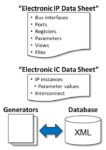Given my physics background I’m ashamed to admit I know very little about quantum computers (QC) though I’m now working to correct that defect. Like many of you I wanted to start with the basics: what are the components and systems in the physical implementation of a quantum “CPU” and how do they map to classical CPUs? I’m finding the answer is not very much. General intent, planar fabrication, even 3D stacking are common, otherwise we must rethink everything else. I’m grateful to Mohamed Hassan (Segment Manager for Quantum EDA, Keysight) for his insights shared in multiple Bootcamp videos. I should add that what follows (and the Keysight material) is based on superconducting QC technologies, one of the more popular of multiple competing QC technologies in deployment and research today.
5 qubit computer – courtesy IBM
What, no gates?
The image above shows a 5-qubit processor, tiny but this immediately untethers me from all my classical logic preconceptions. Each square is a qubit, and the wiggly lines are microwave guides, between qubits and to external connectors. That’s it. No gates, at least no physical gates.
In a rough way qubits are like classical memory bits. It’s tempting to think of the microwave guides as connectors, but that’s not very accurate. Guides connecting to external ports can readout qubit values, but they also control qubits, the first hint of why you don’t need physical gates. A single-input single-output “gate” is implemented by pulsing a qubit with just the right microwave frequency for just the right amount of time to modify that qubit. For example, a Hadamard “gate” will change a pure state, |0> or |1> into a mixed state (|0>+|1>)/√2.
That’s the next shock for a classical logic designer. States in a quantum processor don’t progress through logic. They are manipulated and changed in-place. The reason is apparently self-evident to QC experts, unworthy of explanation as evidenced by the fact that I am unable to find any discussion on this point. My guess is that qubits are so fragile that moving them from one place to another on the chip would instantly destroy coherence (collapsing complex states to pure states) and defeat the purpose of the system.
What about the microwave guides between qubits? This is a bit trickier and at the heart of quantum processing. 2-input (or more input) gates are implemented though a microwave pulse to a controlling qubit which in turn can pulse a target qubit (through one of those qubit-to-qubit connectors) to change its state. This is how controlled NOT (CNOT) gates work to create entangled states.
In short there are no physical gates. Instead, operations (quite different from familiar Boolean operations) are performed by sequences of microwave pulses, modifying qubits in-place. Makes you wonder how the compiler stack works, but that is not something I am qualified to discuss yet.
Keysight Quantum EDA support
The core technologies underlying superconductor-based QCs are Josephson Junctions (JJs), which are the active elements in qubits, and the microwave guides between qubits and to external ports. There is a huge amount of technology here that I won’t even attempt in this short blog, but I will briefly mention the general idea behind the superconducting qubit (for which there are also multiple types). Simple examples I have seen pair a JJ with a capacitor to form a quantum harmonic oscillator. Any such oscillator has multiple quantized resonance energies (quantum theory 101). If suitably adapted this can be reduced to two principal energies, a ground state and an excited state, representing |0> and |1> (or a mix/superposition).
Keysight offer a range of EDA tools in support of building superconducting quantum systems. Their ADS layout platform is already well established for use in building RFICs and, importantly in this context MMICs (monolithic microwave integrated circuits). The same technology with a quantum-specific component library is ideal for building QC layouts. It is also important in building other components of the QC design outside the core processor. A quantum amplifier is needed to boost the tiny signal coming out of the processor – these amplifiers are also built using JJs. It is also important to add attenuators to connectors from the outside non-supercooled world to the processor to minimize photon noise leaking through to the compute element.
Microwave design optimization (using Keysight EM for Quantum CAD) is essential to design not only waveguides but also resonance frequencies with and between qubits. Getting these resonance frequencies right is at the heart of controlling qubits and at the heart of minimizing extraneous noise.
Quantum Circuit Analysis is critical in designing the quantum amplifier and in modeling higher qubit counts. And Quantum System Analysis is a key consideration to optimize for low overall system noise, to check pulsed system response at a system level since qubit gating control is entirely dependent on pulse frequencies and duration.
A quick extra emphasis on noise management. Noise in QCs is far more damaging than it is in classical circuits. Correct QC behavior is completely dependent on maintaining quantum coherence through the operation of a QC algorithm. Noise kills both entanglement and superposition. Production QCs are judged not just by how many qubits they support but also by how long they can maintain coherence – longer times allow for more complex algorithms.
You can learn more about Keysight Quantum EDA HERE. I sat through the full Bootcamp!
Also Read:
Podcast EP317: A Broad Overview of Design Data Management with Keysight’s Pedro Pires
Video EP11: Meeting the Challenges of Superconducting Quantum System Design with Mohamed Hassan
WEBINAR: Design and Stability Analysis of GaN Power Amplifiers using Advanced Simulation Tools










